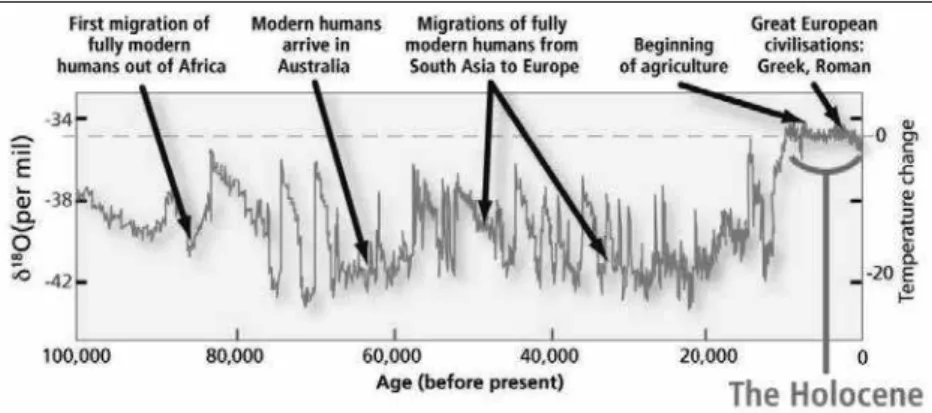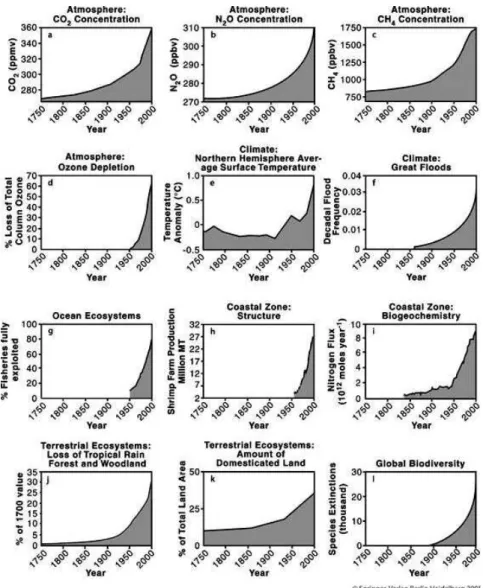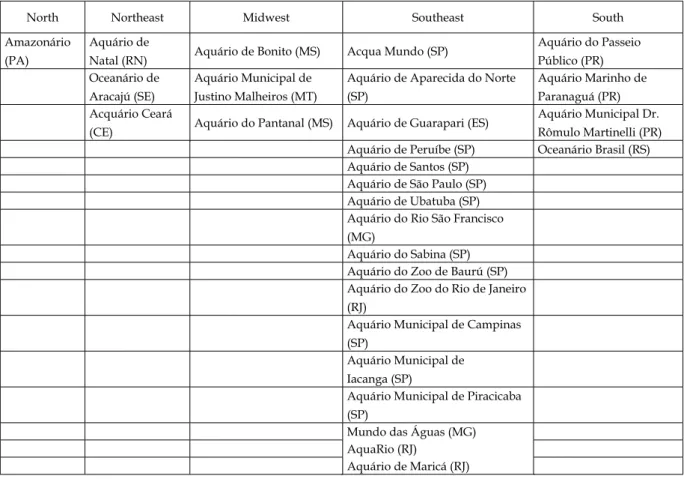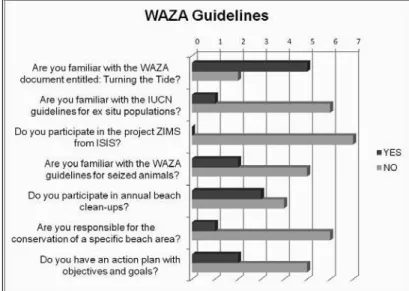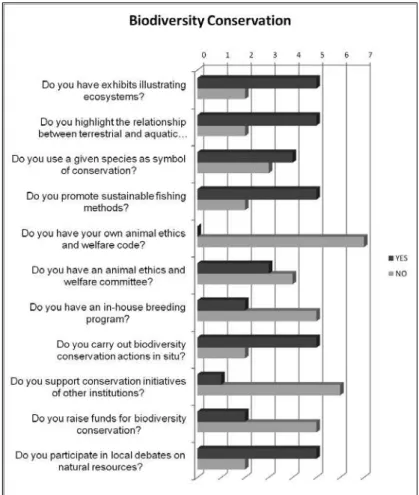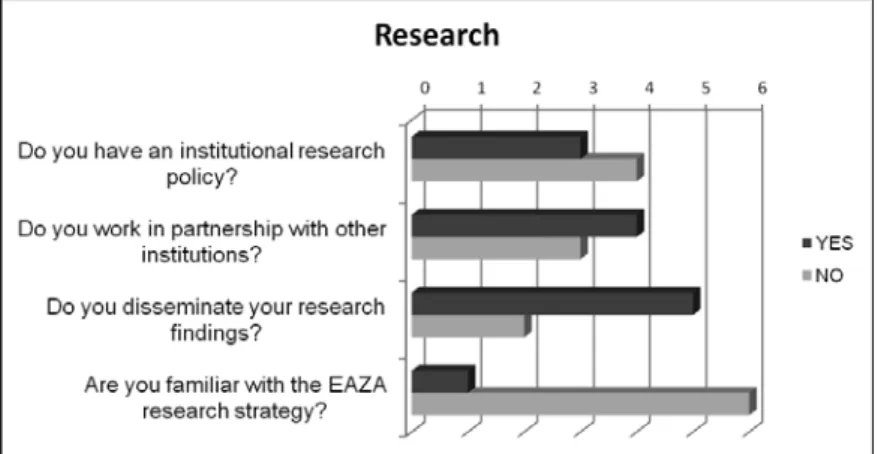Arq
u
ivo
s
d
e
C
iê
n
ci
a
s
d
o
Ma
r
ABSTRACT
The purpose of this study was to determine to what extent a sample of seven Brazilian public aquariums adhered to the guidelines of the World Association of Zoos and Aquariums – WAZA, in their in situ and ex situ efforts at environmental education, research and biodiversity conservation. Information was collected with a questionnaire containing 34 items covering the 9 pillars of the WAZA. Although all aquariums provided some form of environmental conservation, many were unfamiliar with important WAZA, EAZA and IUCN documents. Brazilian public aquariums are advised to join the WAZA community, assume greater responsibilities for conserving local ecosystems, create action plans and in-house animal ethics and welfare codes, intensify breeding programs, raise funds for biodiversity conservation and develop research policies. The study suggests how researchers, activists and aquarium managers can contribute to making the planet an ecologically healthier and safer place for present and future generations, and provides subsidies for further projects relecting the role of public aquariums in the context of the current environmental crisis of the Anthropocene.
Keywords: aquarium, conservation, sustainability, environmental education, biodiversity, WAZA.
RESUMO
O objetivo deste estudo foi avaliar uma amostra de sete aquários públicos brasileiros e determinar até que ponto eles aderiam às diretrizes da Associação Mundial de Zoos e Aquários – WAZA, em suas atividades de educação ambiental, pesquisa e conservação da biodiversidade, in situ e ex situ. As informações foram coletadas através de um questionário contendo 34 itens, abrangendo os nove pilares da WAZA. Apesar de todos os aquários realizarem ações em prol da conservação ambiental, muitos não estavam familiarizados com documentos importantes da WAZA, EAZA e IUCN. Os aquários públicos brasileiros devem integrar-se aos esforços conservacionistas da comunidade da WAZA, assumir maiores responsabilidades para a conservação de ecossistemas locais, criar planos de ação e códigos de ética e bem-estar animal próprios, intensiicar os programas de reprodução, arrecadar fundos para a conservação da biodiversidade e desenvolver políticas de investigação. O estudo sugere como pesquisadores, ativistas e gestores de aquários podem contribuir para tornar o planeta mais sustentável e seguro para as atuais e futuras gerações, e fornece subsídios para projetos que explorem o papel dos aquários públicos no contexto da atual crise ambiental do Antropoceno.
Palavras-chaves: aquário, conservação, sustentabilidade, educação ambiental, biodiversidade, WAZA.
AN EVALUATION OF PUBLIC AQUARIUMS IN SÃO
PAULO (BRAZIL) IN LIGHT OF THE “GLOBAL AQUARIUM
STRATEGY FOR CONSERVATION AND SUSTAINABILITY”
Uma avaliação de aquários públicos em São Paulo (Brasil)
considerando a “ Estratégia Global dos Aquários para a
Conservação e Sustentabilidade”
1 PhD fellow, Post-Graduate Program in Tropical Marine Sciences, Federal University of Ceará (UFC), Brazil. E-mail: priscila.carvalho@
seduc.ce.gov.br.
2 PhD, Associate Professor of the Department of Fisheries Engineering and the Marine Sciences Institute (LABOMAR), Federal University
of Ceará (UFC), Brazil. E-mail: mfurtado@ufc.br
3 PhD, Professor, Federal Institute of Ceará (IFCE), Brazil. E-mail: najila.cabral@gmail.com
INTRODUCTION
Since the onset of the industrial revolution, the impact of human action on earth has been so massive that many researchers hold the view that we have entered a new geological epoch: the Anthropocene. Coined in 2002 by Nobel prize winning atmospheric chemist Paul Crutzen, the term Anthropocene has over the past decade become a
household name in the scientiic community (Steffen
et al., 2007; Zalasiewicz, 2010; Martini & Ribeiro, 2011; WWI, 2013; ICS, 2014). Starting approximately 11,500 years ago, with the waning of the last Ice Age, the Holocene, the period immediately preceding the Anthropocene, was an epoch of unusually stable
weather (Figure 1). Amenable climate conditions
favored the development of human civilizations and allowed for the advent of organized agriculture and the establishment of urban centers. Currently, more people live in urban areas than in rural areas. In fact, the urban world population has grown rapidly since
1950, from 746 million to 3.9 billion in 2014 (United
Nations, 2014). As a result of this exponential populational and industrial growth, a severe environmental crisis, and possibly collapse, looms
ahead. Unbridled production and waste of consumer
goods irrespective of planetary resource limitations is compromising the sustainability of modern human
civilization (Zalasiewicz, 2010; WWI, 2013). Human
activities have affected the Earth’s climate, the chemistry of the oceans, vital terrestrial and aquatic habitats, air and water quality and the cycles of water, carbon, nitrogen and phosphorous, among others, thereby offsetting the balance between the components necessary for life on the planet.
Anthropic changes are now so extensive that human civilization may be considered 0the greatest
geophysical force acting on the planet (Steffen et al.,
2007). Therefore, the International Commission on
Stratigraphy (ICS), the aim of which is to establish a
global geological time scale, recently assigned a
multidisciplinary team of experts to deine, until
2016, the point of transition between the Holocene
and the Anthropocene (ICS, 2014).
In fact, several international organizations committed to conservation on a global scale, such as the Intergovernmental Panel on Climate Change
(IPCC), the International Union for the Conservation of Nature (IUCN), World Wildlife Fund(WWF) and the Worldwatch Institute (WWI), have concluded
that the limits of planetary sustainability have been
exceeded (Nobre et al., 2012; WWI, 2013).
Steffen et al., (2007) used the expression “the Great Acceleration” to describe the exponential growth observed in the Anthropocene associated with demographic explosion, extinction of species, overfishing, concentration of chemical compounds in the biosphere, improper use of soil, water and energy, and other negative develop
ments (Figure 2). A change in these nature-hostile
development patterns to more efficient and ecologically correct models is there fore urgent. Environmental education is bound to play a crucial role in this process.
Public aquariums and zoos (generally referred
to as “public” whether they be private or government owned) are important tools of environmental education due to their ability to strengthen our bond with Nature and promote the concepts of sustainability and conservation of biodiversity
(Mann, 2014). Some consider them the world’s most
successful cultural institutions because they are visited by over 700 million people annually, corresponding to 10% of the world’s population
(WAZA, 2009; Gusset & Dick, 2011, 2014). This is
more than the attendance at soccer matches
worldwide. In Brazil alone, over 20 million people visit zoos and aquariums every year (Barros, 2013).
Many large public aquariums have been built on all continents over the past decades. Technological advances have made it possible to increase the size
of the tanks, such as in the Chinese theme park
ChimeLong Ocean Kingdom which features a 22.8
million liter tank housing 10 whale sharks.
Inaugurated in April 2014, ChimeLong has already
beaten ive Guinness world records (Guinness, 2014).
Over the next three years, three large public
aquariums (Acquário Ceará, AquaRio and Aquário do Pantanal) are expected to open in Brazil.
In 2000, the World Association of Zoos and
Aquariums (WAZA) was founded to provide
leadership and support for zoos, aquariums, and
partner organizations of the world in animal care and welfare, conservation of biodiversity, environmental education and global sustainability,
as aptly expressed in the slogan “United for
Conservation”. Currently, WAZA membership includes over 1,300 of the worldʼs core zoos and aquariums organized in national or regional associations.
As a result of an international collaboration of experts, in 2005 WAZA published the World Zoo
and Aquarium Conservation Strategy (WZACS), with the subtitle “Building a Future for Wildlife”,
urging zoos and aquariums to promote the concept of global biodiversity conservation. In 2009, WAZA published another strategic document entitled “Turning the Tide: A Global Aquarium Strategy for Figure 2 - Examples of the “Great Acceleration” of the Anthropocene epoch: exponential
Conservation and Sustainability” proposing norms, policies and practices for aquariums interested in providing environmental education towards a more sustainable use of resources.
The purpose of the present study was to
determine to what extent Brazilian public aquariums
are aligned with WAZA’s Global Aquarium Strategy for Conservation and Sustainability in their in situ and ex situ efforts at environmental education, research and biodiversity conservation.
MATERIAL AND METHODS
Initially, a sample of seven Brazilian public aquariums was deined, all of which located in the state
of São Paulo by virtue of the availability of logistic and
inancial resources. The managers, environmental
educators and appointed staff of the sampled aquariums were then interviewed using a semi structured questionnaire containing 34 items covering the nine pillars of the WAZA strategy: 1) integrating conservation, 2) conservation of wild populations, 3)
science and research, 4) population management, 5)
education and training, 6) communication, marketing
and public relations, 7) partnerships and politics, 8) sustainability, and 9) ethics and animal welfare
(WAZA, 2009). The interviews were conducted in the
period June 1725, 2014, and lasted 50 minutes on the average. The answers were grouped into four categories according to the elements and ideas expressed: i) WAZA guidelines, ii) conservation of biodiversity, iii) research, and iv) environmental education.
In addition, the facilities of the seven aquariums were observed in loc0, and the literature on the subject
(both printed and online) was reviewed. The collected
information was organized into spreadsheets and
igures using the software Microsoft Excel.
RESULTS AND DISCUSSION
Brazilian public aquariums
Brazil currently has 22 public aquariums in activity and at least 6 under construction (Table I),
North Northeast Midwest Southeast South
Amazonário (PA)
Aquário de
Natal (RN) Aquário de Bonito (MS) Acqua Mundo (SP)
Aquário do Passeio Público (PR) Oceanário de
Aracajú (SE)
Aquário Municipal de Justino Malheiros (MT)
Aquário de Aparecida do Norte (SP)
Aquário Marinho de Paranaguá (PR) Acquário Ceará
(CE) Aquário do Pantanal (MS) Aquário de Guarapari (ES)
Aquário Municipal Dr. Rômulo Martinelli (PR)
Aquário de Peruíbe (SP) Oceanário Brasil (RS)
Aquário de Santos (SP) Aquário de São Paulo (SP) Aquário de Ubatuba (SP) Aquário do Rio São Francisco (MG)
Aquário do Sabina (SP) Aquário do Zoo de Baurú (SP) Aquário do Zoo do Rio de Janeiro (RJ)
Aquário Municipal de Campinas (SP)
Aquário Municipal de Iacanga (SP)
Aquário Municipal de Piracicaba (SP)
Mundo das Águas (MG) AquaRio (RJ)
Aquário de Maricá (RJ)
Table I - Brazilian public acquariums in activity (white cells) or under construction (gray cells), according to geographical region.
which were designed to meet the needs of diversiied,
multicultural audiences and feature innovative and interactive educational exhibits for visitors of all ages.
Description of the sampled aquariums
Most of the 22 public aquariums in activity are
located in the Southeast (eleven in São Paulo alone), which differ with regard to ownership (government/ private), size and age, Figure 3 shows the location of
the seven aquariums in our sample..
Each aquarium is unique. For example, Aquário de Santos, the country’s oldest and most traditional one. Aquário de Ubatuba has a strong conservationist component. Though small, Aquário de Mongaguá is located inside a large ecological park (“A Tribuna”) with a view of the sea. Likewise small, but well structured, Aquário de Peruíbe works
extensively with local schools. On the other hand,
AcquaMundo de Guarujá is more heavily frequented by tourists and offers excellent facilities. Aquário da
Sabina Escola Parque do Conhecimento is part of a large and busy educational compound in Santo
André (a county of São Paulo State). Finally, Aquário
de São Paulo has excellent thematic exhibits, a great diversity of terrestrial and aquatic animals and a
considerable scientiic production. Table II shows
the characteristics of the public aquariums sampled for the study.
Aquarium associations
Only one of the seven aquariums in the sample
was not a member of any aquarium/zoo association.
Six were members of Sociedade Paulista de
Zoológicos (SPZ), four were members of Sociedade de Zoológicos do Brasil (SZB) and one was a member of WAZA (Figure 4).
Although recognizing the importance of joining associations to accomplish their missions and
goals, many Brazilian aquariums are still not properly networked. The main reasons given for this were
Figure 3 - Location of the seven public aquariums sampled for the study.
Name of aquarium
Opening date
Visitors per year
(n)
Tanks
(n) Total water volume (L) tank (L)Largest area (mCovered 2)
Species
(n) Specimens (n)
Aquário de
Santos June, 1945 700,000 31 1,400,000 450,000 3,000 75 1,500
Aquário de
Ubatuba February, 1996 180,000 27 150,000 80,000 1,350 123 350
Aquário de
Mongaguá December, 1996 20,000 14 17,900 7,000 200 26 60
AcquaMundo
(Guarujá) December, 2000 250,000 45 1,500,000 800,000 3,500 150 8,000
Aquário de
São Paulo June, 2006 120,000 41 2,000,000 1,000,000 3,000 300 3,000
Aquário da Sabina April, 2008 170,000 3 243,000 120,000 2,000 26 90
Aquário de
Peruíbe July,2009 50,000 25 18,000 16,000 500 150 500
inancial and bureaucratic dificulties.
However, the WAZA strategy suggests
that larger networked aquariums encourage unafiliated aquariums to join
local, national and international associations.
WAZA guidelines
The interviewees at ive of the
seven sampled aquariums were familiar with the document entitled “Turning the Tide: A Global Aquarium Strategy for Conservation and Sustainability”
(WAZA, 2009) (Figure 5). The WAZA
strategy provides a shared philosophy and high level aspiration for zoos and aquariums across the globe in the form of guidelines and actions that could or should be adopted at different levels ranging from individual public aquariums through to national
and regional aquarium/zoo associations.
WAZA recommend the technical guidelines
of the International Union for the Conservation of Nature (IUCN) with regard to ex situ populations
(IUCN, 2002) for all aquariums, encouraging regional and national associations to make these guidelines
available to all their members. At the time of the study, only one of the aquariums in our sample was
familiar with the IUCN guidelines (Figure 5). It
should be noted that the document was recently
updated with the “IUCN Guidelines on the Use of ex situ Management for Species Conservation” (IUCN/
SSC, 2014). Wildlife management is regulated in
Brazil by IBAMA (Institute for the Environment and
Natural Renewable Resources) through IN
#169/2008 regarding aquariums and zoos, by SisFauna (National System of Wildlife Management) and by the Convention on Biological Diversity (CBD). It should be pointed out that, by way of Supplementary Law #140/2011, wildlife
manage-ment responsibilities have been transferred to regional and local agencies, such as the Coordination
of Biodiversity and Natural Resources (CBRN) in São
Paulo, and the State Department of the Environment
(SEMACE) in Ceará.
As part of the International Species Infor
mation System (ISIS), the internationally
standar-dized and integrated Zoological Information
Management System (ZIMS) was designed to keep
detailed records of successive generations of animals in captivity, even those with relatively short life spans such as colonial organisms. WAZA advises all aquariums to join the ZIMS project, but none of the aquariums in our sample were members of ISIS or participated in the ZIMS project
(Figure 5), although two informed they
were preparing to join in the near future. All the aquariums in our sample
stated they complied with IBAMA
regulations with regard to the registration of animals. In addition, the records of
certain species are kept in regional, national and international studbooks collected by
ISIS and made available to the global community of aquariums and zoos.
In 2003, WAZA published guidelines
on the acceptance of seized or coniscated
animals, recommending that the document be received and adopted by regional Figure 4 - Membership of the sampled aquariums in aquarium/zoo associations.
associations and disseminated to their respective member institutions and that any proposed acquisition
be in accordance with CITES regulations (Convention
on International Trade in Endangered Species of Wild
Fauna and Flora). Only two of the aquariums in our sample were aware of these WAZA guidelines (Figure 5) though all complied with IBAMA regulations
regarding the acceptance of seized animals. Adherence to WAZA guidelines confers international recognition on aquariums, distinguishing them from zoos; in
contrast, current IBAMA regulations do not acknowledge the difference between aquariums and zoos (IN #169/2008).
Beach clean-ups are a popular way of building
awareness of aquatic ecosystem conservation. WAZA guidelines suggest aquariums develop a practical program committing to at least one beach, river or
pond clean-up each year, and take responsibility for
permanently conserving and cleaning one or more
speciic areas. Four of the aquariums in our sample
participated in annual beach cleanups, and one reported providing permanent conservation of a
speciic beach area (Figure 5).
In addition, WAZA recommends the adoption of customized, written aquarium action plans,
incorporating speciic, measurable, achievable, realistic and time-bound objectives (‘SMART’). Only
two of the aquariums in the sample had an action plan with objectives and goals, and the plan was in a format different from that proposed by WAZA. Two other
aquariums are currently preparing a plan (Figure 5).
Conservation of biodiversity
One of the main objectives of the WAZA
initiative is biodiversity conservation (Gusset et al.,
2011, 2014). The actions taken by the seven public
aquariums in the sample to conserve biodiversity are
shown in Figure 6. According to WAZA, preserved
ecosystems are crucial for the welfare of life on earth. Therefore, aquariums should have sustainability
projects and/or exhibits showing the importance of conserving aquatic ecosystems. Five of the aquariums
in our sample featured exhibits with a conservationist
theme to a greater or lesser degree (Figure 6). The
WAZA document also suggests aquariums develop external facilities involving natural habitats with naturallyoccurring indigenous species representing local ecosystems managed in a sensitive, responsible and sustainable way.
To be fully effective, the conservation of aquatic ecosystems and biodiversity should be
closely linked to the management of terrestrial
environments (WAZA, 2009). Thus, aquariums should have exhibits illustrating the complex relationship between these two spheres. Highlighting the services aquatic ecosystems provide to human
well-being makes the exhibits more relevant to the
public and helps understand the need for support to in situ and ex situ conservation initiatives ( Falk, 2014,
Street, 2014). Five of the aquariums in our sample
illustrated relationships between terrestrial and
aquatic environments (Figure 6).
Threatened aquatic species may be used as symbols to transmit conservationrelated messages, create a better understanding of complex ecological processes and obtain public participation and
engagement in conservation projects (Braverman,
2014). Three of the seven aquariums used one or
more species (manatee, turtle, shark and penguin) as symbols in their conservation strategies (Figure 6).
The WAZA document stresses the importance
of avoiding destructive ishing methods, regardless of the context (industrial, sport or subsistence). Global ishing resources are threatened by overishing, by-catch, global warming, ocean acidiication, pollution, the introduction of exotic
species and the continual degradation of aquatic and coastal environments, especially mangroves and
coral reefs. FAO has estimated that 70% of commercial ishing resources in the world are currently exploited, over-exploited or exhausted (FAO, 2012). WAZA
guidelines also recommend that seafood used to feed animals or for consumption in aquarium restaurants come from wellmanaged sustainable
isheries and that products for sale in aquarium gift
shops accord with sustainability and fair trade
guidelines. Five of the aquariums in the sample promoted sustainable ishing methods (Figure 6).
To ensure the wellbeing of aquarium animals and the communication of conservationist messages in aquarium exhibits, WAZA suggests institutions create an inhouse animal ethics and welfare code. Adherence to the code and regular evaluations should be monitored by an animal ethics and welfare committee composed of staff representing different segments, in addition to external collaborators. None of the aquariums in our sample had an inhouse animal ethics and welfare code, but all reported complying with municipal, state or national ethics codes. However, four of the aquariums had an animal ethics and welfare committee composed
international welfare and sustainability benchmarks
in the acquisition, care, management and
transportation of livestock (WAZA, 2009).
The WAZA aquarium community supports the creation of breeding programs, especially for threatened species, similar to those successfully
implemented in many zoos (Braverman, 2014). Such
initiatives require cooperation with other institutions and government agencies, particularly programs involving translocation and reintroduction. Institutional policies should be developed and regularly revised concerning the transfer of surplus
livestock to other reputable institutions, or their
release into the wild when perfectly adequate and authorized. Two of the aquariums in our sample had
breeding programs (Figure 6) and reproduced penguins, starish, seahorses, rays and jellyish.
Aquariums and aquarium associations are advised by WAZA to formally support at least one important conservation project in situ, for example by
hiring or aiding professionals conducting ield work,
offering professional courses, developing compe tences or running campaigns to raise funds for the
conservation of wildlife and habitats. Importance is given to close liaisons with NGOs, aquatic conservation agencies and
IUCN specialist groups. Five of the seven
aquariums in the sample carried out biodiversity conservation actions in situ, but only two aquariums were engaged in raising funds for such projects, and one aquarium supported conservation projects
at other institutions (Figure 6).
Public aquariums possess a huge potential to build awareness around questions of biodiversity, water resources, environmental legislation, environmental impacts, coastal mana gement, pollution and sustainable
isheries. According to WAZA, to help
conserve the local biodi versity, aqua riums should participate in local debates on the use of natural resources. In our
sample, ive aquariums reported partici-pating in such debates (Figure 6).
Research
Because information is more easily
collected from organisms in captivity, researchers often resort to aquariums in order to study the reproductive biology, genetics, behavior, physiology, nutrition, veterinary care, husbandry and re
introduction of animals and plants (Minteer &
Collins, 2013). It is therefore convenient to employ
aquariums as specialized research centers. Figure 7
shows the research actions developed at the seven aquariums sampled for the study.
WAZA recommendations for research at aquariums include the adoption of an institutional research policy and the development or support of at least one research project in situ and one ex situ. The
policy should deine institutional research priorities
and should be regularly evaluated and, if necessary, revised. Three of the aquariums in our sample had
an institutional research policy (Figure 7).
Research can be made more effective and
comprehensive through afiliations with universities,
NGOs and other entities. In addition, research projects may be conducted in partnership with other
aquariums. Five of the seven aquariums worked in partnership with other institutions. Scientiic
discoveries should be shared with the global
aquarium community and with the scientiic
community in general through the publication of Figure 6 - Actions taken by the seven public aquariums in the sample to
papers, reports and web posts. Five of the seven aquariums disseminated their research indings in one form or another (Figure 7).
In response to the irst set of WAZA guidelines (2005), the European Association of Zoos and Aquaria (EAZA) published a document entitled “Developing the Research Potential of Zoos and Aquariums: The EAZA Research Strategy” (EAZA,
2008), containing a generalized action plan which
can be customized for speciic research purposes.
Only one aquarium was familiar with the EAZA research strategy.
Environmental education
According to WAZA (2009), education is one
the main reasons for the existence of aquariums and zoos. Visitors of all ages should be offered learning experiences employing basic signage, interactive interpretation and advanced electronic communi cation systems. In addition to selfexplanatory exhibits, visitorsʼ programs should include lectures capable of sensitizing the public to current
environmental issues. Moreover, tutors may be assigned to accompany small groups for informal interpretation and
closer interaction. Figure 8 shows a
summary of the environmental education activities conducted by the sampled aquariums.
Aquariums should fundamen tally serve as a complement to formal and nonformal education, regardless of visitorsʼ focus and background. All the aquariums in our sample offered incentives for schools and special
groups (Figure 8), such as discounts or
even free entrance. Some of the aquariums partnered with the municipal government to provide transportation for visiting students.
Five aquariums offered education in conser-vation through courses, workshops and lectures (Figure 8) attended mostly by teachers, university
students and aquarium staff, but in many cases also by the general public. The frequency of these activities ranged from monthly to semiannual, with the greatest concentration during school vacations.
Aquariums are particularly appropriate for educational campaigns aimed at sensitizing the public to the importance of conservation and the possibility of joint action towards common objectives
(Falk, 2014). Four aquariums reported participating
in such campaigns (e.g. the movement Zoos and Aquariums for 350, the Decade on Biodiversity (2011-2020), beach clean-ups, protection of sea turtles and migratory ish.
Environmental education should include among its priorities the promotion of environment friendly techniques and sustainable lifestyles. The aquarium should set an example of sustainability by
permanently working towards
reducing its environmental footprint. This should include minimizing water and energy consumption, treating and correctly disposing of liquid and solid waste, and reducing the consumption of disposable supplies. The construction of the
aquarium also should relect concern
for the environment. In addition, environ mentally responsible suppliers should be given preference.
Five aquariums worked towards
reducing their environmental
footprint (Figure 8). Figure 7 - Research actions developed at the sampled aquariums.
Strengthening the concept of environmental responsibility is a WAZA priority. Indeed, integrating environmentfriendly elements into exhibits and setting an example of environmental
responsibility can positively inluence the behavior
of aquarium visitors. The global aquarium community must become fully aware of the role aquariums can play in turning the tide of irresponsible resource use. The present study is meant as a contribution to our current understanding of aquariums as a means of behavior change and as an incentive to the adoption of internationally
acknowledged conservation strategies.
CONCLUSIONS
Adherence to WAZA guidelines for conservation and sustainability was partial in our
sample of seven Brazilian public aquariums.
Although all the aquariums provided some forms of environmental conservation activities many were unaware of the existence of important reference
documents issued by WAZA, EAZA and IUCN. A number of recommendations are in place: Brazilian
public aquariums should i) join the WAZA community, ii) regularly exchange information on species, iii) assume greater responsibilities for conserving local ecosystems, iv) create action plans and inhouse animal ethics and welfare codes, v) intensify breeding programs for conservation, vi) raise funds for biodiversity conservation initiatives, vii) support initiatives of other institutions, and viii) develop institutional research policies for in situ and ex situ projects.
It was shown in this study that the role of public aquariums in society goes far beyond tourism, leisure and entertainment. In fact, the promotion of environmental responsibility, research and biodiversity conservation are among the main reasons for the existence of aquariums. Hundreds of millions of visitors are exposed to exhibits and activities in aquariums and zoos around the world every year. Considering this, and in view of the environmental challenges humanity will face in the coming decades, public aquariums possess an enormous potential for building ecological awareness and mitigating local and global damage to wildlife. The global aquarium community must become fully aware of its role as an agent of transformation in this context. It is hoped the present study will help show researchers, activists and
aquarium managers how Brazilian public aquariums can contribute to making the planet an ecologically
healthier and safer place for present and future generations, and provide subsidies for further
studies and projects relecting relecting the role of
public aquariums in the context of the current environmental crisis of the Anthropocene
Acknowledgments - The authors would like to thank
the staff at the sampled public aquariums for their
time and attention, especially Daniel Monteiro Bortone (Aquário de Mongaguá), Demétrio Carvalho (Aquário de Santos), Hugo Galo Neto (Aquário de Ubatuba), Isabelle Corrales Nunes (Aquário de Peruíbe), Jéssica Cabral Cardoso (Aquário de São Paulo), Marcus Silva Corradini (Aquário da Sabina
Escola Parque do Conhecimento) and Rossana Virga
(AcquaMundo). To Mr. Marcos Antônio de Menezes
Gomes, for his support during the data gathering.
REFERENCES
Barros, Y.M. Zoos e aquários têm papel importante na conservação. Portal da Associação O Eco. Disponível
em:
http://www.oeco.org.br/convidados/27224-z o o s e a q u a r i o s t e m p a p e l i m p o r t a n t e n a
conservacao/ Acesso em 29 de outubro de 2014. Braverman, I. Conservation without nature: the
trouble within situ versus ex situ conservation.
Geoforum, v. 51, p. 4757, 2014.
EAZA. EAZA Strategy 2009-2912. EAZA Executive
Ofice, Amsterdam, 2009.
Falk, J.H. Evidence for the educational value of zoos
and aquariuns. WAZA Magazine, v.15, p.1013, 2014.
FAO. The state of the world isheries and aquaculture 2012.
Food and Agriculture Organizations, Rome, 2012. GUINNESS. China’s Hengqin Ocean Kingdom conirmed as world´s largest aquarium. 2014. Disponível em:
<http://www.guinnessworldrecords.com/
news/2014/3/chinas-hengqin-ocean-kingdom-c o n f i r m e d a s w o r l d s l a r g e s t a q u a r i u m a s
attraction-sets-five-world-records-56471/>Acesso
em 31 de outubro de 2014.
Gusset, M. & Dick, G. The global reach of zoos and
aquariums in visitor numbers and conservation expenditures. Zoo Biology, v.30, p.566569, 2011.
Gusset, M.; Moss, M. & Jensen, E. Biodiversity understanding and knowledge of actions to help
Mann, J.; Ballantyne, R. & Packer, J. International
research on zoo and aquarium visitors – some new perspectives. WAZA Magazine, v.15, p.1821, 2014.
Minteer, B.A. & Collins, J.P. Ecological ethics in
captivity: balancing values and responsibilities in zoo and aquarium research under rapid global change ILAR Journal, v.54, n.1, p.41-51, 2013.
Nobre, C.A.; Reid, J. & Veiga, A.P.S. Fundamentos
cientíicos das mudanças climáticas. Rede Clima/IMPE,
São José dos Campos, 2012.
ICS. International Commission on Stratigraphy. Subcommission on Quaternary Stratigraphy. What is the “Antropocene”? – current deinition and status.
Disponível em: http://quaternary.stratigraphy. org/workinggroups/anthropocene/ Acesso em 31
de outubro de 2014.
IGBP. International Geosphere-Biosphere
Pro-gramme. Antropocene. Disponível em: http://www.
igbp.net/globalchange/anthropocene.4.1b8ae2051
2db692f2a680009238.html. Acesso em 05 de novembro de 2014.
IUCN Technical guidelines on the management of ex situ populations for conservation. Gland Switzerland. Species Survival Commission, 2002.
IUCN/SSC. Guidelines on the use of ex situ management for species conservation. Version 2.0. Gland Switzer land. Species Survival Commission, 2014.
Luebke, J.F.; Kelly, L.D. & Grajal, A. Beyond facts:
the role of zoos and aquariums in effectively engaging visitors in environmental solutions. WAZA Magazine, v.15, p.2730, 2014.
Steffen, W.; Crutzen, P.J. & McNeill, R.S. The Anthropocene: are humans how overwhelming the great forces of mature? Ambio, v.36, n.8, 2007.
Street, W. Conservation education Impact research
at Sea World Parks. WAZA Magazine, v.15, p.3640, 2014.
United Nations. World Urbanization Prospects: The 2014 Revision, Highlights (ST/ESA/SER.A/352).
Department of Economic and Social Affairs, Population Division. New York, 2014.
Vernon, C. Measuring Monterey Bay Aquarium’s role
in inspiring ocean conservation. IZE Journal, n.45, 2009.
WAZA World Association of Zoos and Aquariums. Building a future for wildlife - the World Zoo and Aquarium Conservation Strategy. Bern, 2005.
WAZA World Association of Zoos and Aquariums. Turning the tide: a global aquarium strategy for conservation and sustainability. Bern, 2009.
WWI Worldwatch Institute. Estado do Mundo 2013: A Sustentabilidade Ainda é Possível? Erik assadourian e Tem Prugh org., Salvador, 2013.
Young, O.R.& Steffen, W. “The Earth system: sustaining planetary life-support systems”, p.295–315, in Chapin III,
F.S.; Koinas, G.P. & Folke, C. (eds), Principles of
ecosystem stewardship: resilience-based natural resource management in a changing world. Springer, 401 p.,New
York, 2009.
